Similarities Between Apes And Man
Human Evolution of Class 12
Similarities Between Apes And Man
Absence of tail
Broadened chest due to flattening of sternum
Smaller lumber region due to reduced number of lumbar vertebrae
Relatively larger brain and cranial cavity, efficient memory
Prominent brow ridges above the eyes
Capacity of communication by vocal means
Highly developed facial musculature for expression of rage, surprise, pleasure and laughter by facial gestures.
Tendency to line in pairs as couples, meanstruation in females
Social behavior
Similarities in blood proteins and banding pattern of chromosomes
Chromosomes and Molecular Homology
The DNA content of diploid cells is similar.
Apes possess 48 chromosomes where as humans possess 46 chromosomes.
Bonding patterns of many chromosomes are same in humans and apes.
AB blood groups is found both in apes and man.
Luckerhandl in 1963 proposed that hemoglobin of human and gorilla differ in only one amino acid is each of the two types of polypeptides.
Groundman is 1962 proposed that protein homology is maximum between human and chimpanzee, followed by human and gorilla.
Table: Dissimlarities Between Apes and Man
S. No. Characters Man Ape:
- Face Orthoganathous prognathous
- Curve of vertebral column S-shaped C-shaped
- Jaws and brow ridges Lighter Heavy
- Fore arms Shorter than legs Longer than legs
- Teeth arrangement Half-circle U-shaped
- Diastema Absent Present in the upper jaw
- Cranial capacity 1400 cc 400-450 cc
- Sole of the foot Lies flat on the ground while walking Does not lie flat on the ground while walking
- Habitat Terrestrial life Chefly arboreal Life
- Marking tools and skill workVery high unable to make and employ tools
- Posture Fully erect Less erect
- Knees Knees are striaght in humans Knees are bent while walking
- Toes Big toe is not opposable Big toe is opposite
- Pelvic girdle Pelvic girdle is broad Pelvic girdle is elongated
- Hair Humans have scantly hair over the body Apes have a growth of hair over the body
- Forehead Forehead is vertical in humans Forehead is narrow and slopping in apes
- Nose Possess round nose Possess flat nose
- Brow ridges Browridges are weakly developed Prominent brow ridges are present
- Chin Chin is prominent Chin is small
- Neck Head is erect at the neck of humans Short neck and the head is buried in heavy shoulders of apes
- Head Head is mobile because neck muscles Head is less mobile because the neck muscles are attached at the back are not fully attached of skull
- Foreman magnum Foremen magnum is located below the skull Foreman magnum is located back of the skull
- Intelligency Humans are more intelligent with large Apes are less intelligent with smaller cranial cranial capacity capacity.
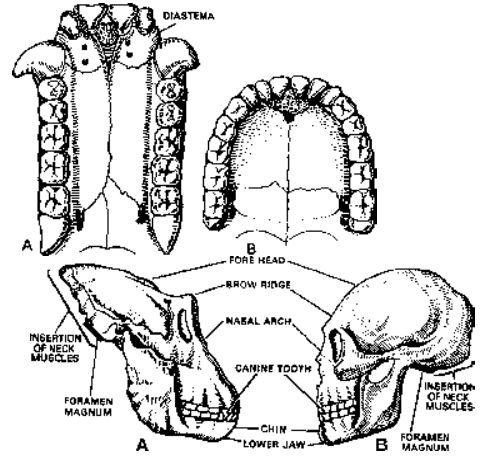
Fig. Teeth lines of ape (A) and man (B) Fig. Skulls of ape (A) and man (B)
Propliopithecus or Pre-Man Ancestor
Found in Egypt about 35 million years old from oligocene period.
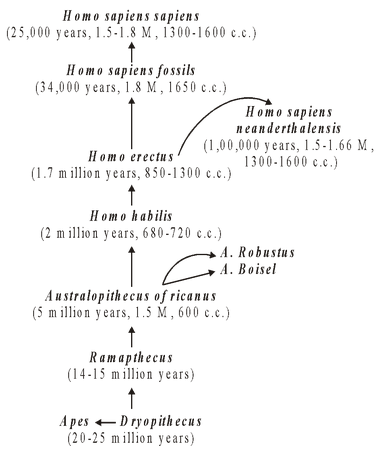
It had characters of man and apes.
First known ape.
Incisor ape-like.
Aegyptopithecus, Limnopithecus, Pliopithecus are all from same evolutionary line
Propliopithecus gave rise to Dryopithecus.
Dryopithecus/Proconsul
Fossil dug by Leakey in 1930 from East Africa from early Miocene rocks
Face prognathous, legs man like but walked on four limbs
Cranial capacity was 400 c.c.
In India obtained from Sivaliks and Bilaspur (HP).
Common ancestor of man and apes or a direct fore runner of man.Common species is D. africanus.
It had arms and legs of the same length. Fig. Graphic presentation of human evolution on the basis
It legs and heels indicate a semi erect posture. of age, height and cranial capacity
Shivapithecus
Found in Shivalik hills of India
Resembled Proconsul, but somewhat like Dryoprithecus, cranial capacity was 750-900 c.c.
Rampithecus /kenyapithecus (Fore runner of hominid stock)
Found in Shivalik hills by E. Lewis (1930) belonged to Miocene period, about 13 million years old.
It was earliest man like Primate.
Incisor and canine teeth-man like
Probably bipedal locomotion
Diet and life habit very similar to modern man.
Ramapithecus represents the first man-like primate.
Australopithecus (Primitive man or ape man)
Australopithecus afticannus (Tuang baby) was discovered by Raymond Dart (1924) with cranial capacity about 450-550 cc and bipedal locomotion and omnivorous, face was prognathus but man like characters like lumber curve, broad-basin pelvic, parabolic dentation.
An almost complete fossil skeleton of 30-25 lac years old had discovered by C.D. Johanson (1981) from Ethopia.
It was Australopithecus robustus a female skeleton resembling Australopithecus, but more ape like and named as Lucy. They were vegetarian with cranial capacity - 600 cc.
Southern ape/first man-ape/African ape-man.
Omnivorous.
Height - 120 cm.
Face – Prognathous
Prominent brow ridges but no chin.
All fossils belonging to early Pleistocene period and are believed to give rise to genus Homo.
Formed crude stone tools
It was upright, lived in caves, hunted animals by bones and animals horn.
Homo habilis (Early true man or the tool maker)
Evolved about 2 million years ago during early Pleistocene period
Fossil discovered by Leaky (1960-1964) from East Africa.
Cranial capacity was about 680 cc and they used hands, walked straight (bipedal locomotion) omnivorous. They used chipped stone tools.
He led community life in caves and greatly cared for the young.
Height - 150 cm.
Prominent brow ridges
Protruded jaws, lower Jaw lightly built. had small cannines.
Omnivorous.
Homo erectus
Evolved between 1.7 and 1.5 million years ago during middle Pleistocene period from Homo habilis. They walked erect over long legs, prognathus face, used stone and bone tools, fire and some primitive type of speech had developed.
Homo erectus-erectus or Pithecanthropus (Java man)
Reported by Eugene Dubois (1891) near river in Java
It was progenathus and cranial capacity was 950 cc.
Lived in cave, knew use of fire for hunting, defence and cooking.
Jaws were massive with huge teeth.
Chin absent.
Eye brow ridges were present.
Height - 160 cm
Walked upright.
Learned the used and construction of tools.
Knew use of fire for hunting defence and cooking.
Home erectus pekinensis or Sinanthropus pekinensis (Peking man)
W.C. Pai (1924) reported from Peking.
Fossiles discovered from caves in Choukoutien near Peking by Davidson black.
Cranial capacity 1075 cc, omnivorous.
Peking man was probably cannibal
Height - 150 cm.
Heavy bony eyebrows ridges.
Low slanting face, head and chinless face.
Used fire.
Tools were sharper made up bones, stones and quartz.
Homo rhodesiensis (Rhodesian Man)
Fossils were found in Rhodesia in the large limestone cave.
Receding forehead.
Heavy eyebrow ridges.
Cranial capacity 1300 cc.
It might be even more primitive than Java man.
Homo soloensis (Solo Man)
Fossils were found on the bank of solo river in Java.
Descended from Pithecanthropus.
Heavy brow rides.
Receding forehead.
Cranial capacity - 1300 cc.
Homo erectus mauritanicus (Atlantic man)
Reported in 1955 from Algeria, in 1965 from Moracco and Hungery
Lesser cranial capacity then Java man and Peking man
Used fire and lived in caves
Probably migrated from Africa to Asia and Europe
Homo heidelbergensis (Heidelberg man)
Found in 1907 from Heidelberg, Germany
Teeth man like, jaw ape like
Chin absent
Heidelberg man is regarded as an ancestor to Neanderthal man
Sapiens
It evolved from homo erectus in Africa during late Pleistocene man. There was a second spurt in brain size.
Homo sapiens neanderthalensis (Neanderthal man) Fossil discovered by C. Fuhlrott (1856) from Neander that valley of Germany.
This resembled modern man, cranial capacity 1400-1450 c.c.
Made beautiful tools for hunting, used animal hides as clothing built hut like structures, lived social life, division of labour, buried their dead.
Probably had ability of speech. They were omnivores.
There were no agricultural practices.
The skull bones were thick, forehead was low.
Eyebrow ridges were heavy.
Height 150 cm.
Social life, division of labour and buried their dead.
They were Omnivorous.
Homo sapiens fossilis (Cro-Magnon man)
Fossils found from Cro-Magnon, France by Mac Gregor (1868)
Replaced Neanderthal man about 35.000 years ago Sharp nose and chin, forehead broad, cranial capacity about 1600 c.c, face orthognathus with elevated narrow nose.
It is believed that Cro-Magnon man is direct descendent of Neanderthal man
They were cave dweller, hunter with domesticated dogs, did some excellent cave paintings, used ivory ornaments and animals skin garments.
They were omnivores.
Lack of eyebrow ridges.
Height - 180 cm.
Homo sapiens sapiens (Modern man)
Developed from Cro-Magnon about 10,000 yeas ago after last glacial period in the regions of Caspian and Mediterranean seas.
Cranial capacity 1450 cc.
Cultivated plants and domesticated animals.
Communication through writing.
Thinning of skull bones, four flexor in vertebral column.
Man has undergone cultural evolution.
Homo sapiens futuris
According to Dr. Shapiro, Homo sapiens sapiens will change into Homo sapiens futuris.
Taller and hairless body, dome shaped head.
omplicated and well developed brain.
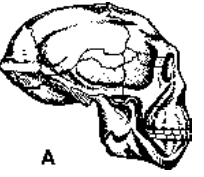
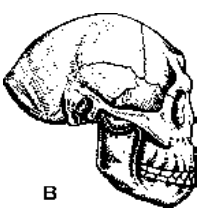
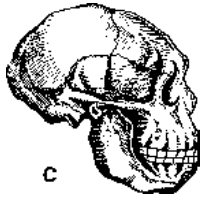
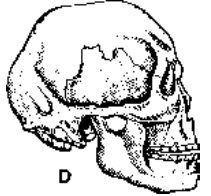
Fig. A. Skull of Java ape man; B. Skull of Peking man; C. Skull of Neanderthal man; D. Skull of Cro-Magnin man









